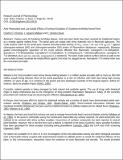| dc.description.abstract | Various parts of Gardenia ternifolia (leaves, roots and stem bark) have been reported by traditional healers
as a remedy against malaria fever. The aerial parts are coated with shiny materials rich in flavonoid aglycones. The
crude acetone wash of the aerial parts showed anti-plasmodial activity of IC50 values 1.06 and 0.94 μg mL-1
against
chloroquine-resistant (W2) and chloroquine-sensitive (D6) strains of Plasmodium falciparum, respectively. Bioassay
guided chromatographic separation of the crude extracts afforded five flavonoids; (naringenin-7-O-methylether,
quercetin-4, 7-O-dimethylether, kaempferol-7-O-methylether, 4, 5-Dihydroxy-6, 7-dimethoxyflavanone, naringenin-4,
7-O-dimethyl-ether) and two steroids; (stigmasterol, β-sitosterol). The same crude acetone surface extract as well as the
pure isolates showed moderate larvicidal effects against 2nd instar Ae. aegypti larvae. Naringenin-7-O-methyl-ether was
the most potent principle. | en_US |

